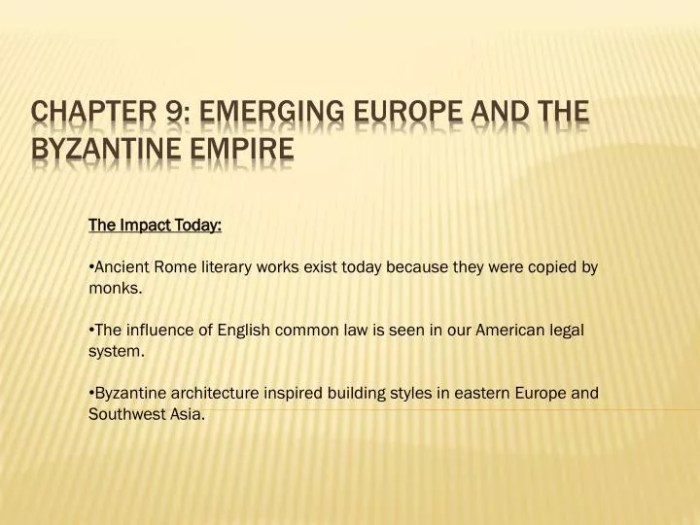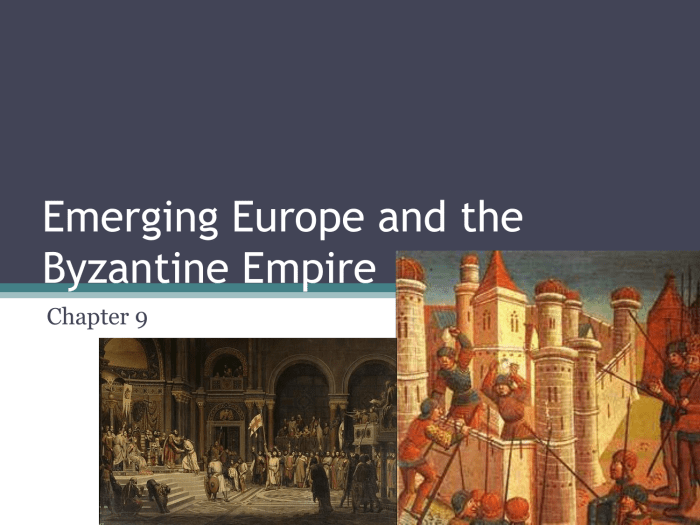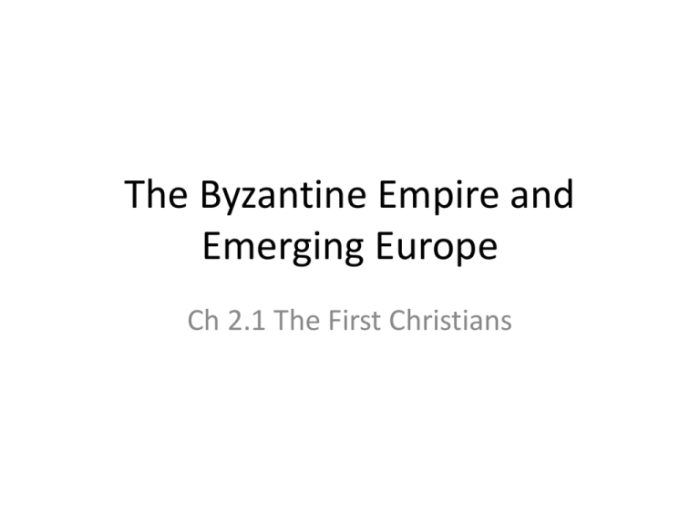The byzantine empire and emerging europe – The Byzantine Empire and the Dawn of Modern Europe explores the intricate relationship between the Byzantine Empire and the emerging nations of Western Europe during the Middle Ages. This transformative period witnessed a dynamic interplay of political, economic, and cultural forces that shaped the course of European history.
From the grandeur of Constantinople to the rise of feudalism in the West, this narrative unravels the threads that connected these two worlds, illuminating their profound impact on each other and the legacy they left for posterity.
1. The Byzantine Empire
An Overview

The Byzantine Empire, also known as the Eastern Roman Empire, was a continuation of the Roman Empire that existed from the 4th to the 15th century. Its capital was Constantinople, the former Byzantium. The empire was a major power in the Mediterranean and Europe, and its culture and institutions had a profound impact on the development of Western civilization.
The Byzantine Empire was founded by Constantine the Great in 330 AD, when he moved the capital of the Roman Empire from Rome to Constantinople. The empire reached its peak under Justinian I in the 6th century, when it controlled most of the Mediterranean region and much of Europe.
However, the empire began to decline in the 7th century, and it was eventually conquered by the Ottoman Turks in 1453.
Political Characteristics
- The Byzantine Empire was an autocracy, with the emperor holding absolute power.
- The empire was divided into provinces, each governed by a governor appointed by the emperor.
- The Byzantine army was one of the most powerful in the world, and it was instrumental in defending the empire from its enemies.
Economic Characteristics
- The Byzantine Empire was a major trading center, and its economy was based on agriculture, trade, and manufacturing.
- The empire had a sophisticated system of taxation, and it was able to generate a large amount of revenue.
- The Byzantine Empire was also a major producer of gold, and its currency was the most stable in Europe.
Cultural Characteristics
- The Byzantine Empire was a center of learning and culture, and its scholars made important contributions to philosophy, science, and literature.
- The empire was also a major center of art and architecture, and its churches and mosaics are still admired today.
- The Byzantine Empire was a Christian empire, and its official religion was Eastern Orthodoxy.
Relationship with the Eastern Orthodox Church
The Byzantine Empire had a close relationship with the Eastern Orthodox Church, and the church played an important role in the empire’s political and social life. The emperor was the head of the church, and he appointed the patriarch of Constantinople, who was the leader of the Orthodox Church.
The Eastern Orthodox Church was a major source of support for the Byzantine Empire, and it helped to legitimize the emperor’s authority. The church also played a role in the empire’s educational system, and it provided social services to the poor and needy.
2. The Rise of Western Europe: The Byzantine Empire And Emerging Europe

The rise of Western Europe during the Middle Ages was a complex process that was influenced by a number of factors. These factors included the decline of the Roman Empire, the rise of the Catholic Church, and the development of feudalism.
The decline of the Roman Empire left a power vacuum in Western Europe, which was filled by a number of small, independent kingdoms. These kingdoms were often at war with each other, and they were unable to provide stability or security for their people.
The rise of the Catholic Church helped to bring order to Western Europe. The church provided a common set of beliefs and values, and it helped to create a sense of community among the people of Europe. The church also played a role in the development of education and culture in Western Europe.
Feudalism was a system of social and political organization that developed in Western Europe during the Middle Ages. Feudalism was based on the relationship between lords and vassals. Lords were landowners who provided protection and support to their vassals, who were typically knights or other warriors.
In return, vassals provided military service to their lords.
Role of the Catholic Church, The byzantine empire and emerging europe
- The Catholic Church played a central role in shaping Western European society and culture.
- The church provided a common set of beliefs and values, and it helped to create a sense of community among the people of Europe.
- The church also played a role in the development of education and culture in Western Europe.
Development of Feudalism
- Feudalism was a system of social and political organization that developed in Western Europe during the Middle Ages.
- Feudalism was based on the relationship between lords and vassals.
- Lords were landowners who provided protection and support to their vassals, who were typically knights or other warriors.
- In return, vassals provided military service to their lords.
Emergence of Nation-States
- During the Middle Ages, a number of nation-states began to emerge in Western Europe.
- These nation-states were based on a common language, culture, and history.
- The emergence of nation-states was a major factor in the development of modern Europe.
Essential Questionnaire
What factors contributed to the rise of Western Europe during the Middle Ages?
The rise of Western Europe was influenced by factors such as the growth of trade and commerce, the development of new technologies, and the emergence of strong centralized monarchies.
How did the Byzantine Empire influence Western European art and architecture?
Byzantine art and architecture had a profound impact on Western European art, particularly in the areas of mosaics, iconography, and the use of domes and arches.
What role did the Catholic Church play in shaping Western European society and culture?
The Catholic Church played a central role in shaping Western European society and culture, providing a unifying force, promoting education, and influencing political and social institutions.

